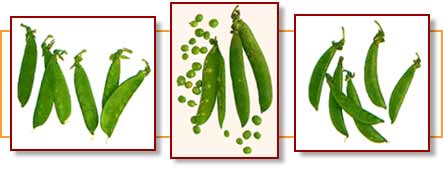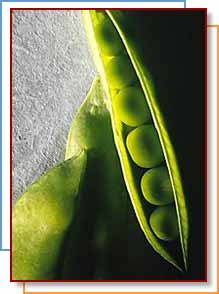
Peas have been used in the dry form since ancient times, and
archaeologists found them in Egyptian tombs. It was not until the
sixteenth century that more tender varieties were developed and eaten
fresh. Today only about 5 % of all peas grown are sold fresh. More than
half of all peas sold are canned and most of the rest are frozen.
Green peas are actually a member of the legume family. This family
includes plants that bear pods enclosing fleshy seeds. Green peas do not
require the long cooking times that are required by dried legumes such as
split peas and pinto beans. Peas are a good low calorie source of protein.
A 100-calorie serving of peas (about ¾ cup) contains more protein than a
whole egg or a tablespoon of peanut butter and has less than one gram of
fat and no cholesterol.
|
| Peas |
Serving
size 1/2 cup cooked (80g)
|
Amounts
Per Serving |
% Daily
Value |
| Calories
70 |
|
| Calories
from Fat 0 |
|
| Total Fat
0g |
0% |
| Sodium 0mg |
0% |
| Total
Carbohydrate 13g |
4% |
|
Dietary Fiber 4g |
14% |
|
Sugars 5g |
|
| Protein 4g |
|
| Vitamin A |
15% |
| Vitamin C |
20% |
| Calcium |
2% |
| Iron |
6% |
* Percent Daily Values are based on a
2,000 calorie diet. |
|
| |
|
Fresh green peas should be refrigerated. Half of their sugar content
will turn to starch within six hours if they are kept at room temperature.
Low temperatures also preserve their texture and nutrient content. Look
for pods that are firm, have glossy pods with a slightly velvety feel,
filled to appear almost bursting, and peas should not rattle loosely in
the pod. Pods should not be dull, yellowed, or heavily speckled.
Snow peas should be shiny and flat, with very small peas that are
barely visible through the pod. Smaller pods are the sweetest and the most
tender. Sugar snap peas should be bright green, plump, and firm.
It is best to serve all types of fresh peas the day they are purchased.
If they must be stored, place them in a perforated plastic bag in the
refrigerator. Do not wash them before they are stored. Shell green peas
right before you cook them.
Rinse peas before shelling them. To shell peas, pinch the stem off with
your fingernails and pull the string down the length of the pod. The pod
will pop open and the peas can be pushed out of the pod with your thumb.
When finished, wash all peas.
Rinse snow peas and sugar snap peas before use. To trim snow peas, cut
the tips from both ends of the pod. This can be done with kitchen shears.
Sugar snap peas need to have the strings removed before eaten cooked or
raw. The string runs around both sides of the sugar snap pod. It is
easiest to start from the bottom tip and pull the string up the front, and
then snap the stem off and pull the string down the back of the pod.
Green peas are nestled within large, bulging, grass green pods that are
typically round and sweet. The green pea pods are tough, do not have good
flavor, and therefore, are not eaten.
 |
| Snow Peas |
Green Peas |
Sugar Snap Peas |
Snow peas (Chinese pea pods) and sugar snap peas are more often found
fresh, but many companies are now selling them frozen. These peas are
eaten raw or cooked with the pod intact.
Recipes
 Vegetarian Paella Vegetarian Paella
Makes 4 servings.
Ingredients
1½ Tbsp olive oil
1 large onion, chopped
½ tsp paprika
1 ½ cups long grain brown rice
3 ¾ cups stock or vegetable broth
¾ cups dry white wine
14 oz can tomatoes, chopped with juice
1 Tbsp tomato paste
½ tsp tarragon
1 tsp dried basil
1 tsp oregano
1 red pepper, roughly chopped
1 green pepper, roughly chopped
3 stalks celery, finely chopped
3 cups mushrooms, washed and sliced
½ cup snow pea pods
2/3 cup frozen peas, trimmed
1/3 cup cashew nut pieces
Salt and pepper to taste
Heat oil; sauté onions and garlic until soft. Add paprika and rice and
continue to cook for 4 -5 minutes or until rice is transparent. Stir
occasionally. Add stock, wine, tomatoes, tomato paste, and herbs and
simmer for 10 - 15 minutes. Add peppers, celery, mushrooms, and pea pods
and continue to cook for another 30 minutes or until rice is cooked. Add
peas, cashews, salt and pepper to taste. Heat through and place on a large
heated serving dish.
Nutrition information per serving: Calories 454, Fat, 12g, Saturated Fat
2g, Carbohydrates 71g, Cholesterol 0mg, Dietary Fiber 10g, Sodium 295mg,
Protein 12g.
Find more in our
recipe database!
|



